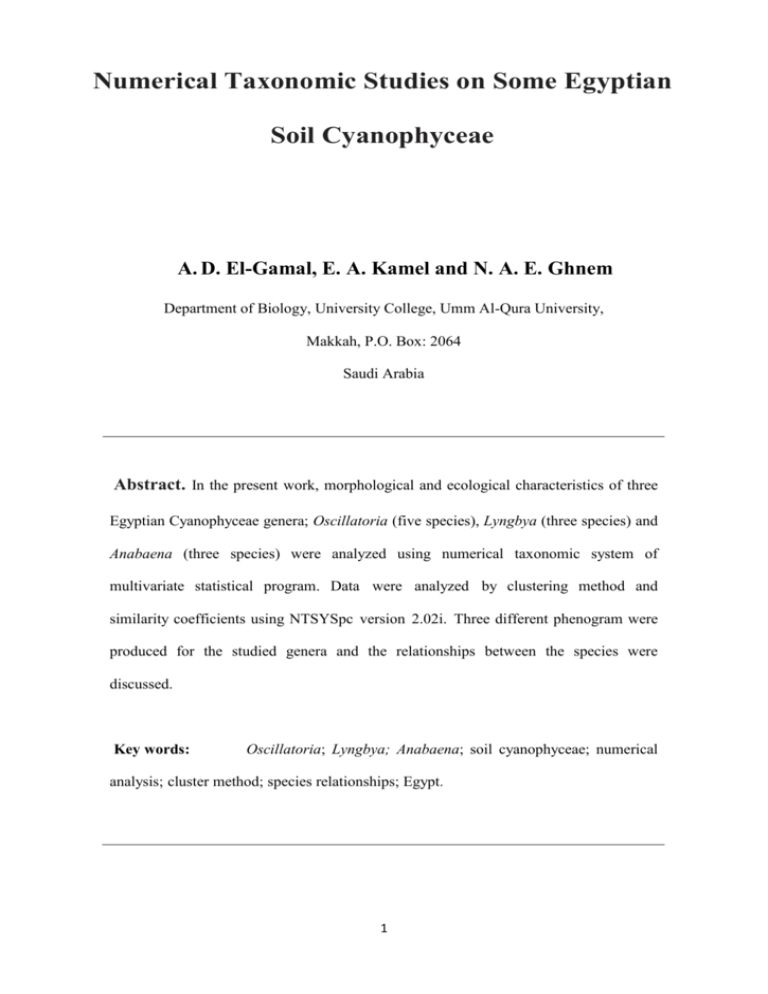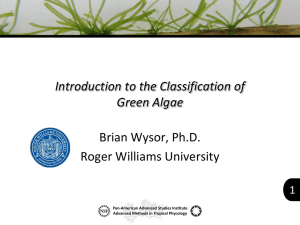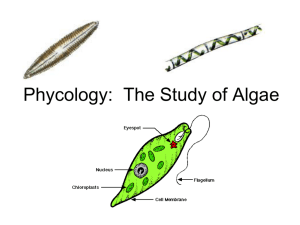20061683_20060619_New
advertisement

Numerical Taxonomic Studies on Some Egyptian Soil Cyanophyceae A. D. El-Gamal, E. A. Kamel and N. A. E. Ghnem Department of Biology, University College, Umm Al-Qura University, Makkah, P.O. Box: 2064 Saudi Arabia Abstract. In the present work, morphological and ecological characteristics of three Egyptian Cyanophyceae genera; Oscillatoria (five species), Lyngbya (three species) and Anabaena (three species) were analyzed using numerical taxonomic system of multivariate statistical program. Data were analyzed by clustering method and similarity coefficients using NTSYSpc version 2.02i. Three different phenogram were produced for the studied genera and the relationships between the species were discussed. Key words: Oscillatoria; Lyngbya; Anabaena; soil cyanophyceae; numerical analysis; cluster method; species relationships; Egypt. 1 Recently, Hoffmann et al. (2005) Introduction In soil algae, the system of proposed a revision to the classification has based largely on cyanobacterial classification under morphological characters and on the botanical code. Wacklin (2006) some ecological data which have cleared that the classification used evolved over many years ago. In for cyanobacteria is based mainly on some cases, such data lack any morphology. In many cases the established genetic basis as well as classification the few morphological characters incongruent with the phylogeny of available to cyanobacteria. The evaluation of this distinguish between organisms or classification is complicated by the speak relationships fact that numerous strains are only (Robert, 1973). Attempt to apply the described morphologically and have numerical taxonomy system program not been isolated. Moreover, the was tried as the calculated simple phenotype of many cyanobacterial matching coefficients and a drawn strains phenogram laboratory cultivation. imbalance of many keys. This relationships between procedure may preclude inadvertent species are not yet definitely solved, weightings of characters. but the separation of a special genus are about insufficient their might solve the alters is known during to be prolonged The different is justified and all up to date 2 corresponding and validly described criteria: Thallus (Wacklin et al., 2009). morphology and dimension & size of heterocysts and color, thallus vegetative cells. & Materials and Methods reproductive Culturing and isolation of algae. forming blue-green algae were also The following methods were applied cultured in nitrogen-free Z-medium on air-dried soil samples, using Z- (El-Gamal, medium (Staub, 1961) and modified species are shown in Plate 1. 1995). Heterocyst- The studied Watanabe medium (El-Nawawy et al., 1958) for isolation and culturing Numerical analysis. The presence of algae. Semi-solid medium as or absence of each of the different described by El-Ayouty & Ayyad character was treated as a binary (1972) and filter paper method as character in a data matrix (coded 1 recommended by Esmarch (1914) and 0, respectively) for computation. were applied. About 10 g of the soil Data were analyzed by clustering sample were also placed in flasks method and similarity coefficients containing 100 ml of the sterilized using liquid medium. The Petri-dishes as (Rohlf, 1998). The method applied is well as flasks were incubated at 30°C based under continuous light (2500 lux). expresses the relationships at the The identification of algae was studied carried out using the following coefficient in phenograms. 3 NTSYSpc on cluster species version analysis as 2.02i and similarity examined. The clusters can then be Results and Discussion Taxonomy classification is the and science has of related to each other by means of a several phenogram. In this type of functions. The first is to describe the classification, individual characters species which is the basic taxonomic gain an importance not given to them unit. The second is to catalogue in hierarchical taxonomy. The great these species into some arrangement advantage of this method is that it enabling the relationships between requires the determination of a large species to be recognized. Numerical number classification the method also requires the use of a quantification of similarities and computerized data base and is now differences, with no weighting being used as the basis of a number of given to any one character. It should rapid identification systems, e.g. the therefore be possible to quantify the NTsys program. is based on of characteristics. The relationships between cells on the basis of the number of similarities For the numerical analysis, the algal they share, relative to the number species examined. species had a unique code number to were numbered. Each facilitate the running of computation The method is basically a cluster program as summarized in Table 1. analysis in n-dimensional space, where n is the number of variables 4 Numerical analysis morphological and numerical analysis were shown in of Tables 2, 3 and 4 (respectively). ecological characters. The morphological and ecological criteria of the examined The phenogram produced by the species been analysis of the studied species of the considered as attributes and are used genus Oscillatoria based on coding for a number of numerical analyses of 20 attributes shown in Fig. 1. This using phenogram shows that the examined (Plate the NTSYSpc 1) UPGMA version have method of 2.02i (Rohlf, species have a total similarity 1998) program in order to illustrate coefficient of about 1.48. At this the these level, O. subbrevis (5) was split off species on their similarities in these from the other species and then at attributes. 1.42 level, the remaining species are relationships between separated into two groups. The first In the genus Oscillatoria a total of one composed of O. nigra (3) and O. 20 characters have been observed, sancta (4), which they distinguished within the genus Lyngbya a total of from each other at the 1.32 level. 12 characters have been observed, The other group included O. amoena whereas in Anabaena, 27 characters (1) and O. anguina (2), which they have been scored. The data of the distinguished from each other at the morphological 1.19 level. characters were and used ecological in the 5 According to the Prescott (1982), the environmental five species of Oscillatoria were Kondratyeva et al. (1974) measured separated based on the size of cell size of Microcystis aeruginosa trichome whereas, O. scanta was and found that larger cells occurred greater than 10 µ, while the other under species was less than 10 µ. It was conditions. They pointed out that seemed that both O. amoena and O. underestimation of the effect of subbrevis are closely related to each environment on cell size may cause other. While, O. anguina and O. errors in recognition of intraspecific nigra were seemed as if they were taxa. Variations in size of the cells of close together. The Prescott key is filamentous adopted in part, on the color of (BGA) in response to variation in trichome to differentiate between environmental conditions have also species. been reported. In the taxonomy of blue-green algae, The phenogram produced by the cell size plays an important role at analyses of the studied species of the species level, but in nature Lyngbya based on a total of 12 numerous morphological deviations characters is shown in Fig. 2. The which are not genetically stable exist phenogram obtained shows that the within specific algal taxa. The cell examined species of Lyngbya have a size of most species is influenced by total similarity coefficient of about 6 less conditions. favorable Blue Green culture Algae 1.54. At this level, L. hieronymusii in Fig. 3. The phenogram obtained (7) was split off from the other two shows that the examined species of species and then at the level of 1.11, Anabaena have a total similarity L. birgei and L. martensiana (6 & 8) coefficient of about 1.45. At this were distinguished from each other. level, A. wisconsinense (10) was split off from the other two species Prescott (1982) has depended on the and then at the level of 1.33, A. filament diameter in the separation torulosa and A. variabilis (9 & 11) of the three species of Lyngbya and were distinguished from each other. accordingly, he has separated L. Following the system of Prescott birgei from L. hieronymusii. In (1982), the classification of the three addition, he has depended on the species of Anabaena was depended environmental conditions associated on their nature in the aquatic with Lyngbya species to separate L. environment martensiana. Accordingly, there was otherwise, therefore he was able to no clear kinship between the three separate A. wisconsinense from A. algal species. torulosa. On the other side, A. as euplanktons or torulosa was separated from A. On the other hand, the phenogram variabilis depending on the presence produced by the analyses of the of studied species of Anabaena based heterocysts. Therefore, A. torulosa on a total of 27 characters is shown and A. variabilis had the same path 7 akinetes near or far from during identification, while A. indifferent environmental conditions wisconsinense had a different path. (Komárek, 1991). The present data are in agreement with Prescott’s key study (1982). References El-Ayouty. E.Y., Ayyad, M.A. 1972. The use of programmed systems like Studies on blue-green algae NTsys program may explain the real of relationships between species using Description of some species many of the characteristics of the in a wheat field. Egypt. J. species and may reduce the problems Bot. 15: 283-321. the Nile Delta-l- that correspond to the taxonomists El-Gamal, A.D. 1995. Systematical during the classification of species. It studies on the algae isolated is concluded that both field and from some cultivated areas culture information are useful in and laboratory studies on the enhancing our knowledge of blue- effect of light, temperature green algal systematics. The main and problems selected soil algae. Ph.D. met morphological in applying criteria in Azhar the Egypt. morphological variability features on three Thesis, Fac. of Sci., Al- Cyanophyta classification arise from considerable humidity in with University, Cairo, El-Gamal, A.D., Ghanem, N.A.E., Y. El-Ayouty, E.Y., Shehata, 8 E.F. 2008. Studies on soil Komárek, J. 1991. A review of algal flora in Kafr El-Sheikh water-bloom Governorate, Microcystis Egypt. Egyptian J. Phycol. 9: 1-23. El-Nawawy, A. S.; Lotfi, forming species, with regard to populations form M., Japan. Arch. Hydrobiol. Fahmy, M. 1958. Studies on Algolg. Stud. Stuttgart, 64: the ability of some blue- 115-127. green algae atmospheric to fix nitrogen Kondratyeva, N.V., Kovalkenko, and O.V., Kysolva, O.A. 1974. their effect on growth and Variability of cell width of yield of paddy. Agric. Res. Microcystis aeruginosa Kutz Rev. 36(2): 308-320. emend. Esmarch, F. 1914. Untersuchungen Eluek. and Oscillatoria agardhii Com. über die Verbreitung der (Cyanophyta) Cyanophyceen auf und in cultivation conditions. Biol. Verschiedenen Abst. 58: No. 29821, 3194. Böden Hedwigia. B. 55: 224-273. Hoffmann, L., Komárek, under Prescott, G.W. 1982. Algae of the J., Western Great Lakes Area, Kaštovský, J. 2005. System Otto of Publishers, Koenigstein, W. cyanoprokaryotes cyanobacteria) - state 2004. Koeltz Germany. Algol. Stud. 117: 95-115. 9 Science Robert, H. 1973. Electrophoretic freshwater Lakes. Academic protein profiles as criteria in Dissertation in Microbiology. the taxonomy of fungi and Department algae. Torrey Botanical Club, Chemistry and Microbiology, 100(5): 253-259. University Rohlf, F.J. 1998. numerical NTSYSpc taxonomy of of Applied Helsinki, Finland. and Wacklin, P., Hoffmann, multivariate analysis system Komárek, user guide. Exeter Software, Nomenclatural validation of New York, USA. the Staub, R. 1961. J. L., genetically cyanobacterial 2009. revised genus Ernährungsphysiologisch- Dolichospermum (Ralfs ex autökologische Bornet et Flahault) comb. Untersuchungen an der planktischen Blaualge Nova. Fottea 9(1): 59-64. Oscillatoria rubescens DC. Schweiz. Z. Hydrol. 23: 83198. Wacklin, P. 2006. Biodiversity and Phylogeny of Planktonic Cyanobacteria in Temperate 10







